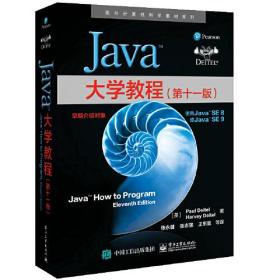
Java大学教程
全新正版 极速发货
¥ 110.42 6.6折 ¥ 168 全新
库存3件
广东广州
认证卖家担保交易快速发货售后保障
作者(美)保罗·戴特尔(Paul Deitel),(美)哈维·戴特尔(Harvey Deitel) 著
出版社电子工业出版社
ISBN9787121317606
出版时间2017-06
装帧平装
开本16开
定价168元
货号1201529537
上书时间2024-11-14
- 最新上架
商品详情
- 品相描述:全新
- 商品描述
-
作者简介
Paul Deitel和Harvey Deitel是优选热卖的编程语言教材和专业图书作家,“How to Program”系列是其很负盛名的一套计算机编程教材,已经销售近40年,并被翻译成中文在内的十几种语言。他们成立的Deitel & Associates公司是一家靠前知名的企业培训和写作公司, 专门进行计算机编程语言、对象技术、移动应用开发及Internet和Web软件技术方面的培训和写作,出版了品质的编程专业的大学教材、 专业图书以及LiveLessons视频课程。
目录
Chapter 1 Introduction to Computers and Java
1.1 Introduction
1.2 Computers:Hardware and Software
1.3 Data Hierarchy
1.4 Computer Organization
1.5 Machine Languages,Assembly Languages and High—Level Languages
1.6 Introduction to Object Technology
1.7 Operating Systems
1.8 Programming Languages
1.9 Java and a Typical Java Development Environment
1.10 Test—Driving a Java Application
1.11 Web2.0:Going Social
1.12 Software Technologies
1.13 Keeping Up—to—Date with Information Technologies
1.14 Wrap—Up
Chapter 2 Introduction to Java Applications
2.1 Introduction
2.2 Your First Program in Java:Printing a Line of Text
2.3 Modifying Your First Java Program
2.4 Displaying Text with printf
2.5 Another Application:Adding Integers
2.6 Memory Concepts
2.7 Arithmetic
2.8 Decision Making:Equality and Relational Operators
2.9 Wrap—Up
Chapter 3 Introduction to Classes,Objects,Methods and Strings
3.1 Introduction
3.2 Declaring a Class with a Method and Instantiating an Object of a Class
3.3 Declaring a Method with a Parameter
3.4 Instance Variables, set Methods and get Methods
3.5 Primitive Types vs.Reference Types
3.6 Initializing Objects with Constructors
3.7 Floating—Point Numbers and Type double
3.8 (Optional) GUI and Graphics Case Study: Using Dialog Boxes
3.9 Wrap—Up
Chapter 4 Control Statements: Part 1
4.1 Introduction
4.2 Algorithms
4.3 Pseudocode
4.4 Control Structures
4.5 if Single—Selection Statement
4.6 if...else Double—Selection Statement
4.7 while Repetition Statement
4.8 Formulating Algorithms: Counter—Controlled Repetition
4.9 Formulating Algorithms: Sentinel—Controlled Repetition
4.10 Formulating Algorithms: Nested Control Statements
4.11 Compound Assignment Operators
4.12 Increment and Decrement Operators
4.13 Primitive Types
4.14 (Optional) GUI and Graphics Case Study: Creating Simple Drawings
4.15 Wrap—Up
Chapter 5 Control Statements: Part 2
5.1 Introduction
5.2 Essentials of Counter—Controlled Repetition
5.3 for Repetition Statement
5.4 Examples Using the for Statement
5.5 do...while Repetition Statement
5.6 switch Multiple—Selection Statement
5.7 break and continue Statements
5.8 Logical Operators
5.9 Structured Programming Summary
5.10 (Optional) GUI and Graphics Case Study: Drawing Rectangles and Ovals
5.11 Wrap—Up
Chapter 6 Methods: A Deeper Look
6.1 Introduction
6.2 Program Modules in Java
6.3 static Methods, static Fields and Class Math
6.4 Declaring Methods with Multiple Parameters
6.5 Notes on Declaring and Using Methods
6.6 Method—Call Stack and Activation Records
6.7 Argument Promotion and Castin
6.8 Java API Packages
6.9 Case Study:Random—Number Generation
6.10 Case Study: A Game of Chance; Introducing Enumerations
6.11 Scope of Declarations
6.12 Method Overloading
6.13 (Optional) GUI and Graphics Case Study: Colors and Filled Shapes
6.14 Wrap—Up
Chapter 7 Arrays and ArrayLists
7.1 Introduction
7.2 Arrays
7.3 Declaring and Creating Arrays
7.4 Examples Using Arrays
7.5 Case Study: Card Shuffling and Dealing Simulation
7.6 Enhanced for Statement
7.7 Passing Arrays to Methods
7.8 Case Study: Class GradeBook Using an Array to Store Grades
7.9 Multidimensional Arrays
7.10 Case Study: Class GradeBook Using a Two—Dimensional Array
7.11 Variable—Length Argument Lists
7.12 Using Command—Line Argumen
7.13 Class Arrays
7.14 Introduction to Collections and Class ArrayList
7.15 (Optional) GUI and Graphics Case Study: Drawing Arcs
7.16 Wrap—Up
Chapter 8 Classes and Objects: A Deeper Look
8.1 Introduction
8.2 Time Class Case Study
8.3 Controlling Access to Members
8.4 Referring to the Current Objects Members with the this Reference
8.5 Time Class Case Study: Overloaded Constructors
8.6 Default and No—Argument Cons
8.7 Notes on Set and Get Methods
8 .8 Composition
8.9 Enumerations
8.10 Garbage Collection and Method finalize
8.11 static Class Members
8.12 static Import
8.13 final Instance Variables
8.14 Time Class Case Study: Creating Packages
8.15 Package Access
8.16 (Optional) GUI and Graphics Case Study: Using Objects with Graphics
8.17 Wrap—Up
Chapter 9 Object—Oriented Programming: Inheritance
9.1 Introduction
9.2 Superclasses and Subclasses
9.3 protected Members
9.4 Relationship between Superclasses and Subclasses
9.5 Constructors in Subclasses
9.6 Software Engineering with Inheritance
9.7 Class Object
9.8 (Optional) GUI and Graphics Case Study: Displaying Text and Images Using Labels
9.9 Wrap—Up
Chapter 10 Object—Oriented Programming: Polymorphism
10.1 Introduction
10.2 Polymorphism Examples
10.3 Demonstrating Polymorphic Behavior
10.4 Abstract Classes and Methods
10.5 Case Study: Payroll System Using Polymorphism
10.6 final Methods and Classes
10.7 Case Study: Creating and Using Interfaces
10.8 (Optional) GUI and Graphics Case Study: Drawing with Polymorphism
10.9 Wrap—Up
Chapter 11 Exception Handling:A Deeper Look
11 .1 Introduction
11.2 Example: Divide by Zero without Exception Handling
11.3 Example: Handling ArithmeticExceptions and InputMismatchExceptions
11.4 When to Use Exception Handling
11.5 Java Exception Hierarchy
11.6 finally Block
11.7 Stack Unwinding and Obtaining Information from an Exception Object
11.8 Chained Exceptions
11.9 Declaring New Exception Types
11.10 Preconditions and Postconditions
11.11 Assertions
11.12 (New in Java SE 7) Multi—catch: Handling Multiple Exceptions in One catch
11.13 (New in Java SE 7) try—with—Resources: Automatic Resource Deallocation
11.14 Wrap—Up
Chapter 12 ATM Case Study, Part 1: Object—Oriented Design with the UML
12.1 Case Study Introduction
12.2 Examining the Requirements Document
12.3 Identifying the Classes in a Requirements Document
12.4 Identifying Class Attributes
12.5 Identifying Objects States and Activities
12.6 Identifying Class Operations
12.7 Indicating Collaboration Among Objects
12.8 Wrap—Up
Chapter 13 ATM Case Study, Part 2: Implementing an Object—Oriented Design
13.1 Introduc
相关推荐
— 没有更多了 —



















以下为对购买帮助不大的评价